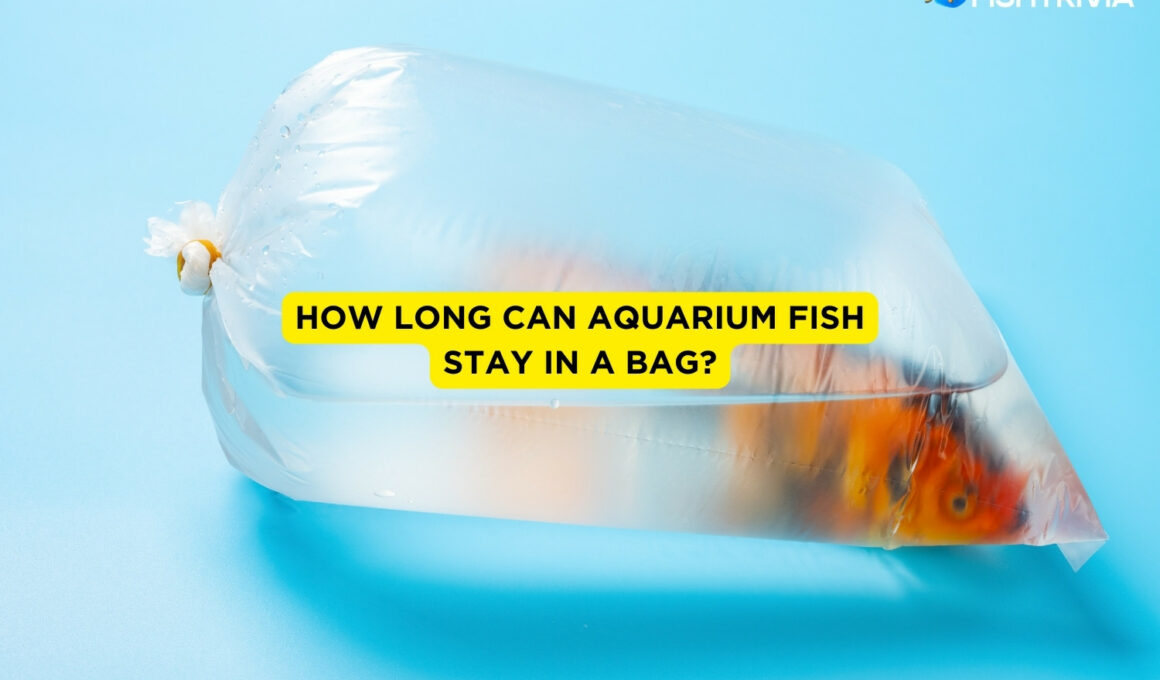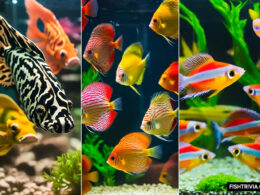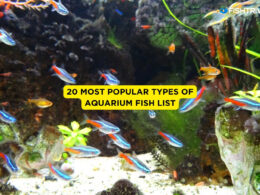In this article Show
Imagine, you are looking for a fish, calling here to fulfill your collection. But unfortunately, you found it far from where you live. Now you need to carry it in a fish-carrying bag and you are concerned about the survival of your fish.
Depending on the container size, quantity of oxygen, the weather, and the fish from within the container, the time to put the aquarium fish in a bag varies.
For between 7 and 9 hours, a fish stays happily with water in a bag. Many fish pet shops add more oxygen to the bag, which ensures it can last up to 48 hours. The fish’s longevity depends largely on how much air is inside the bag.
It is important to know how long they have been in the bag before you get the fish before you carry your fish home. In a plastic bag with the sealing of water and oxygen fingerlings or small fish are typically shipped inside.
The majority needs between 1.5 and 2 gallons of water. The bag should be 3 mm thick and should be 18 “wide x 32” at least. In this article, we will be discussing the survival of your fish in a plastic bag and every other aspect including this. Let’s get started;
Also worth reading;
- Freshwater Fish for 10-Gallon Tank: Which Are The Perfect?
- How To Fix A Leaking Aquarium Without Draining
- How Long Should You Boil Driftwood For Your Aquarium?
- How To Tie Down Wood In An Aquarium
- Aquarium Heater Size: What Size Heater Do You Need in a Fish Tank?
Aquarium Fish Staying In A Bag
Here is all that you need to know about leaving an aquarium fish in a bag;
1. Fish in a Ziplock Bag
For over 30 minutes, a fish should not live inside a Ziplock container. It is also critical that the bag is clean and has no holes.
Make sure the ziplock is the largest and do not bring more than one fish in the pouch. The longevity of a fish in a bag depends on the consistency of the water.
Do not keep the ziplock bag upside-down as water-resistant seals open and trigger air leaks – which can place fish at significant risk. Not all ziplock bags are good to hold fish – incorrectly built bags will drain contaminants and cause water damage.
You will have to reduce the travel time from about 30 minutes and about 15 minutes while holding a saltwater fish. With bag-limiting chemicals, saltwater is easily poisoned.
Ziplock bags are also known to leak and bring fish a significant threat. Besides leaks in the air, the zipper may collapse and the oxygen remaining inside may further become exhausted.
2. Fill The Bag With Oxygen
About one-third of the bag volume can be taken up by water. The bag is normally filled with water and there will be no space for air or oxygen which will choke the fish along the trip.
Also useful for permitting oxygen to enter the water in the bag is low water. This will keep your fish alive for hours, or even for a day if the right conditions are fulfilled. Aim to take no longer than 5 to 7 hours to fly with your fish in a bag.
It’s appropriate to fill your fish bag with air during short journeys (like one hour at most). In that amount of time, you hopefully would not face some suffocation problems. However, it is best to load the bag with pure oxygen if it takes hours of travel.
3. More Fish Need More Oxygen
If more than one fish is in one bag, the oxygen consumption rate is higher. If the bag you get from the shop contains any fish, you must remember this when you decide how long you can leave your fish in your bag. You should get your fish out of the bag as fast as possible.
The transport of your fish will excite them, thereby increasing their oxygen intake. This means that during transportation they absorb more oxygen than during the rest. When you’ve got hold of it, try to treat your new fish gently, particularly if your travel time is a few hours long, during your transport from the shop to the house.
4. Survival Length Without Oxygen
The water can flow while the fish are in deeper water, which in turn will help the fish collect oxygen from the surface.
Fish can last for around 2 days in shallow water, even though it is the only fish in the container, and can live for up to a week. Fish have competed for more oxygen in a crowded situation, which results in a gas loss – which ensures that this can not continue for 2 days.
5. Fish Condition In The Bag
They can remove waste into the water if you place a fish in bag that you have recently eaten. Fish waste involves bacteria that can alter the water’s pH and potentially damage the fish.
Since plastic sackcloths are not created for the prevention of carbon dioxide, fish ultimately run out of oxygen and get sick. When fish are lucky enough in their breathing sack, they obtain at least 48 hours of oxygen.
It’s not advisable to place fish in the pouch until it’s 48 hours without food and the water you use comes from the tank directly.
Dead Fish Reduce The Oxygen Level
Oxygen is often absorbed by dead fish in a bag. More bacterial multiplication requires oxygen which in turn creates more toxic metabolites which can affect the living in the bag.
Furthermore, bacteria expand into the slime of dead fish, thus reducing the amount of oxygen in the water. This lowers the time spent in the bag by live fish.
Dead fish can also deplete their existing oxygen rapidly. Therefore, a dead fish can not be stored in a jar for more than forty minutes to escape discomfort.
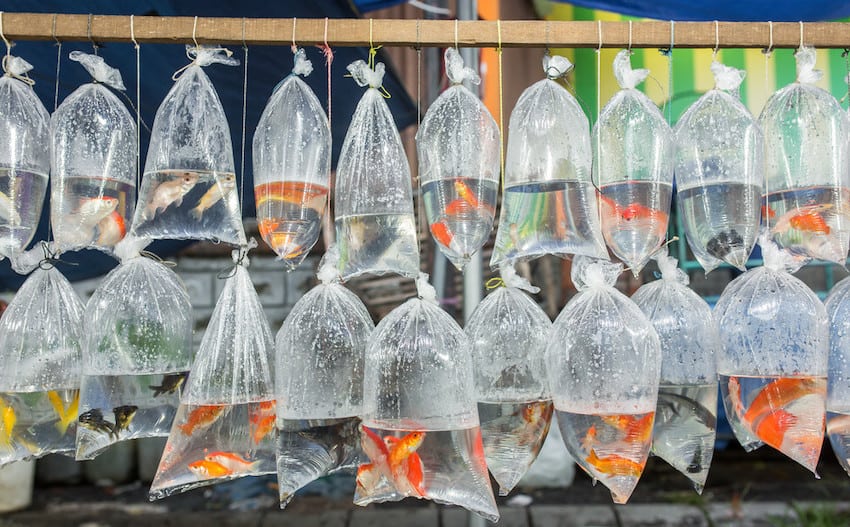
Temperature Effect On Aquarium Fish
The temperature of fish will be mild, so when outdoors are very warm or cold, the water temperature in the bag can climb too high or drop too low. This will affect your fish, cause disease, or even death when the weather is harsh.
If the weather is incredibly warm, try to ride in an air-conditioned car so that the temperature is more regulated. You may also use cold or hot packs for a trip longer than 45 minutes to control the outside water temperature according to the outside conditions.
Extreme temperatures will make your new fish a tragedy, so look out for that every time you bring them. A bigger bag makes it easier to fill up more free space – pure oxygen. With more oxygen in a larger bag, the fish could live longer in the bag.
The fish would now have more oxygen to try to consume from the water’s surface. This stops the oxygen in the bag from being restored by opening it again and again.
However, you must bear in mind that the amount of oxygen that you have can not be dependent on. It isn’t endless. You must get it to freshwater as fast as possible to save your fish.
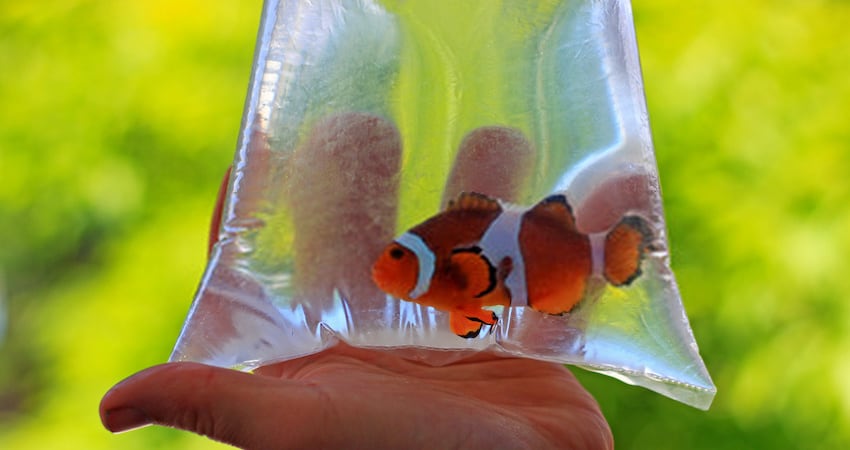
Transferring Fish From Bag To Tank
Transferring fish is one of the crucial processes. Don’t bring your new fish into your tank directly when you are moved from your pack.
Place the bag over the water surface and slowly start to align with that of the tank. Start by moving about 20-25% of the water from your tank into your bag so the fish get used to the water in your tank.
After a few minutes, add about half to see if even after the shift, your fish looks still relaxed. You can just let the freshwater swim free in the tank after you have allowed your fish to get used to it all the time. There are some processes that must be followed;
1. Tank Water Shouldn’t Get In
Let no water come into your tank from the supermarket. You aim to keep water in the bag higher. You should be concerned enough for your fish to come out of the bag and into the tank. You should use a net to scoop from the bag into the tank bath.
2. Ensure That The Fish Is Comfortable
Keep an eye on the action and any obvious signs of distress in your fish. If you always tend to scratch on other items in the aquarium, then the water might be too alkaline for you.
In this situation, part of the water can be supplemented by freshwater. You want your fish to steadily and safely adapt to their new home. By tossing them into a new and uncertain environment, you risk stressing your fishing.
Conclusion
It is not especially straightforward to answer how long a fish will live in a bag. Many aspects influence the length of the trip so they will keep safe and stable in the bag.
Know what they are to make an accurate estimation of the amount of time your fish can live in a bag. The most crucial factor is to minimize the potential side effects of harmful temperature fluctuations and increasing carbon dioxide by moving fish within a bag as much as possible.
Remember, the fish from the bag must be taken out. Depending on the form of the container, it takes from 7-9 or 48 hours. You will have a long and stable life if you follow the instructions for extracting the fish from the bag.






